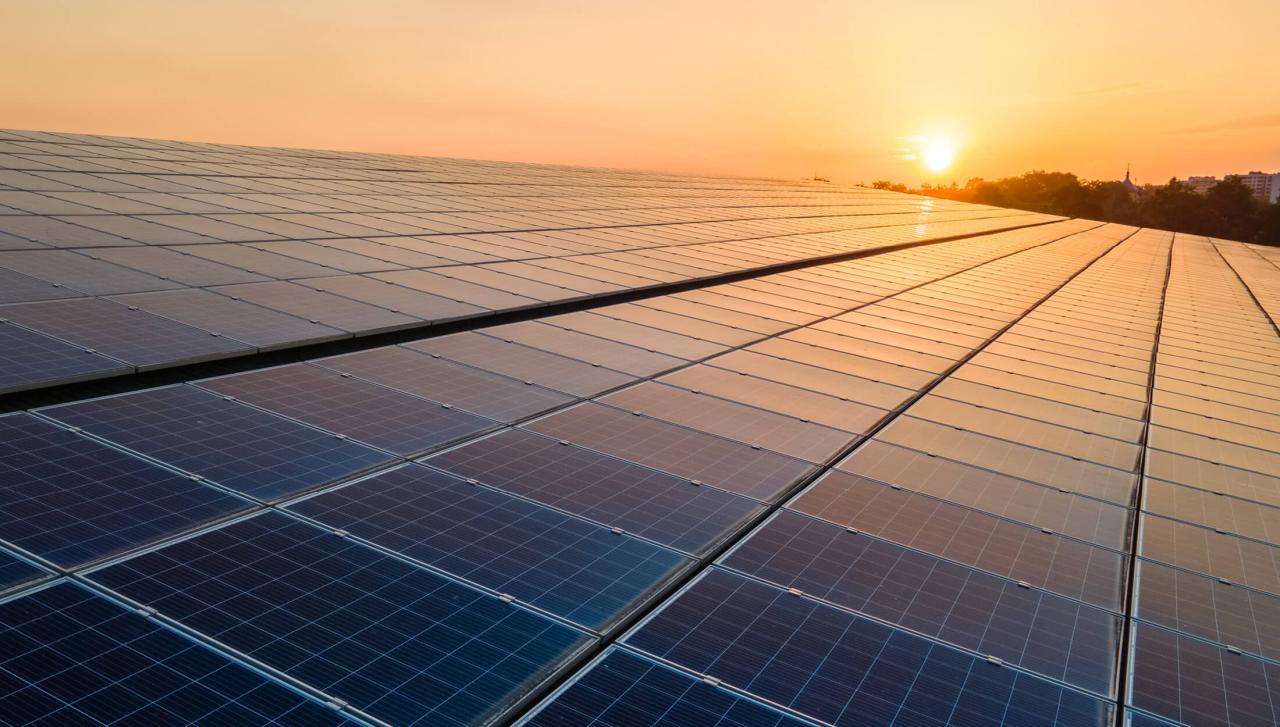Sustainable Energy Technologies Advancements revolutionize the way we harness energy, paving the path towards a greener future. From solar to wind and hydroelectric power, these advancements are shaping our world in unprecedented ways.
As we delve deeper into the advancements of sustainable energy technologies, we uncover the transformative power they hold in mitigating environmental challenges and securing a sustainable future for generations to come.
Sustainable energy technologies refer to the methods and practices that harness renewable resources to generate electricity, heat, and fuel. These technologies aim to minimize environmental impact, reduce carbon emissions, and promote long-term sustainability.
Comparison of Traditional Energy Sources
Traditional energy sources such as fossil fuels (coal, oil, and natural gas) are finite resources that contribute to air and water pollution, greenhouse gas emissions, and climate change. In contrast, sustainable energy technologies like solar, wind, hydropower, and geothermal energy utilize abundant and clean resources to produce energy with minimal environmental impact.
Key Advancements
- Solar Photovoltaic (PV) Technology: The efficiency and affordability of solar PV panels have improved significantly, making solar energy a viable option for residential, commercial, and industrial applications.
- Wind Turbine Technology: Advances in wind turbine design and engineering have increased the capacity and reliability of wind power generation, making it a competitive source of renewable energy.
- Battery Storage Systems: Innovations in battery technology have enhanced the storage capacity and efficiency of renewable energy systems, enabling reliable power supply even when the sun is not shining or the wind is not blowing.
- Smart Grid Technology: Integration of smart grid systems allows for better management of energy distribution, optimizing the use of renewable energy sources and reducing energy waste.
Importance
Sustainable energy technologies play a crucial role in mitigating climate change, reducing dependence on fossil fuels, and preserving natural resources for future generations. By transitioning to renewable energy sources, we can create a cleaner and healthier environment while ensuring a sustainable energy future.
One of the emerging trends in engineering is the utilization of Digital Twins, which involves creating virtual models of physical assets. This technology enables engineers to simulate and analyze the performance of equipment in real-time, leading to improved efficiency and reduced downtime.
Solar Energy

Solar energy technology has seen significant advancements in recent years, making it an increasingly popular and viable option for both residential and commercial use. With improvements in efficiency, innovative products, and a focus on sustainability, solar energy is revolutionizing the way we power our homes and businesses.
Advancements in Solar Energy Technology
One of the key advancements in solar energy technology is the development of more efficient solar panels. Traditional silicon-based solar panels have been replaced by more efficient materials like thin-film solar cells, which are lighter, more flexible, and easier to install. In addition, advancements in solar tracking systems have improved the energy output of solar panels by allowing them to follow the sun’s path throughout the day.
Examples
– Solar roof tiles: These innovative tiles are designed to seamlessly integrate into the roof of a building, providing a sleek and aesthetically pleasing alternative to traditional solar panels.
– Solar-powered windows: Transparent solar cells can be integrated into windows, allowing them to generate electricity while still allowing natural light to enter the building.
– Solar-powered outdoor furniture: From solar-powered benches to charging stations, outdoor furniture equipped with solar panels can provide a sustainable energy source for public spaces.
Benefits of Using Solar Energy
Using solar energy offers numerous benefits for both residential and commercial purposes. Some of the key advantages include:
– Cost savings: By generating your own electricity from solar panels, you can reduce or even eliminate your electricity bills.
– Environmental impact: Solar energy is a clean and renewable energy source, reducing greenhouse gas emissions and dependence on fossil fuels.
– Energy independence: Solar energy allows you to generate your own power, providing a reliable source of energy even during grid outages.
– Long-term savings: Investing in solar energy can increase the value of your property and provide a long-term return on investment.
Efficiency Improvements in Solar Panels
Advancements in solar panel technology have led to significant improvements in efficiency, with newer panels able to convert a higher percentage of sunlight into electricity. Improved cell design, better materials, and increased manufacturing precision have all contributed to the increased efficiency of solar panels, making them a more attractive option for those looking to harness the power of the sun.
Wind Power
Wind power technology has seen significant advancements over the years, making it a key player in the renewable energy sector. The harnessing of wind energy through wind turbines has become more efficient and cost-effective, leading to a rapid growth in wind power installations worldwide.
Advancements in Wind Power Technology
With advancements in materials, design, and engineering, wind turbines have become larger, more durable, and more efficient in converting wind energy into electricity. The use of advanced control systems and sensors has also improved the overall performance and reliability of wind power systems.
Impact of Wind Farms
Wind farms have both positive and negative impacts on local communities and ecosystems. While they contribute to reducing greenhouse gas emissions and creating clean energy, the construction and operation of wind farms can have visual, noise, and wildlife impacts on the surrounding areas. Proper siting and planning of wind farms are essential to minimize these impacts.
Challenges in Integrating Wind Power
One of the main challenges in integrating wind power into the existing energy grid is the variability of wind resources. Wind power generation is dependent on wind speed and direction, which can fluctuate unpredictably. This variability poses challenges for grid operators in balancing supply and demand. The development of energy storage technologies and smart grid solutions is crucial to overcoming these challenges.
Leading Countries in Wind Power Generation
Countries like China, the United States, Germany, and India are among the leaders in wind power generation. These countries have made significant investments in wind energy infrastructure and have favorable policies to promote the growth of wind power. China, in particular, has emerged as the largest producer of wind energy in the world, with a rapidly expanding wind power capacity.
Hydroelectric Power
Hydroelectric power is a renewable energy source that harnesses the power of flowing water to generate electricity. It is a well-established technology that has been in use for decades, providing a reliable and sustainable source of energy.
Technological Advancements in Hydroelectric Power Generation
In recent years, there have been significant advancements in hydroelectric power generation technology. One notable advancement is the development of more efficient turbines and generators, which have increased the overall efficiency of hydroelectric power plants. Additionally, the implementation of digital monitoring and control systems has improved the operational efficiency of hydroelectric facilities, allowing for better management of power output and grid integration.
Environmental Impact
While hydroelectric power is considered a clean energy source, large-scale hydroelectric projects can have significant environmental impacts. The construction of dams and reservoirs can disrupt local ecosystems, alter river flow patterns, and lead to the displacement of communities and wildlife. It is important for developers to carefully assess and mitigate these impacts through proper planning and environmental management strategies.
Efficiency Comparison
Traditional hydroelectric dams have been the dominant form of hydroelectric power generation, but newer technologies such as run-of-river and pumped-storage hydroelectric plants offer alternative approaches to harnessing hydropower. These newer technologies have the advantage of being more flexible and environmentally friendly, as they do not require large reservoirs or significant alterations to river ecosystems. While traditional dams may have higher energy storage capacity, newer technologies can be more efficient in terms of grid integration and overall environmental impact.
Contribution of Hydroelectric Power to Renewable Energy Goals
Hydroelectric power plays a crucial role in achieving renewable energy goals by providing a reliable and sustainable source of electricity. It is a key component of many countries’ energy mix, helping to reduce reliance on fossil fuels and lower greenhouse gas emissions. As advancements continue to be made in hydroelectric technology, it is expected to play an increasingly important role in the transition to a more sustainable energy future.
In conclusion, Sustainable Energy Technologies Advancements are not just about technological progress; they represent a shift towards a more sustainable and eco-friendly world. By embracing these innovations, we can create a cleaner and brighter future for all.







